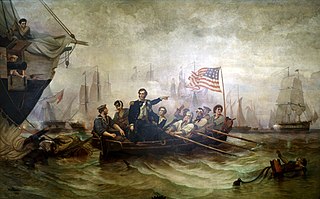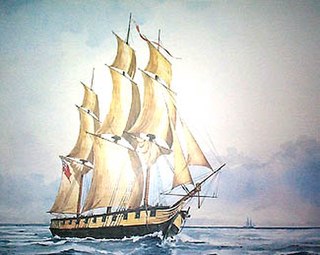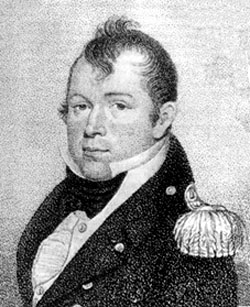
Oliver Hazard Perry was an American naval commander, born in South Kingstown, Rhode Island. A prominent member of the Perry family naval dynasty, he was the son of Sarah Wallace Alexander and United States Navy Captain Christopher Raymond Perry, and older brother of Commodore Matthew C. Perry.

Erie is a city on the south shore of Lake Erie and the county seat of Erie County, Pennsylvania, United States. It is the fifth-most populous city in Pennsylvania and the most populous in Northwestern Pennsylvania with a population of 94,831 at the 2020 census. The Erie metropolitan area, equivalent to all of Erie County, had a population of 270,876 in 2020. Erie is located approximately 80 miles (130 km) from Buffalo, 90 miles (140 km) from Cleveland, and 120 miles (190 km) from Pittsburgh.

A brig is a type of sailing vessel defined by its rig: two masts which are both square-rigged. Brigs originated in the second half of the 18th century and were a common type of smaller merchant vessel or warship from then until the latter part of the 19th century. In commercial use, they were gradually replaced by fore-and-aft rigged vessels such as schooners, as owners sought to reduce crew costs by having rigs that could be handled by fewer men. In Royal Navy use, brigs were retained for training use when the battle fleets consisted almost entirely of iron-hulled steamships.

The Battle of Lake Erie, also known as the Battle of Put-in-Bay, was fought on 10 September 1813, on Lake Erie off the shore of Ohio during the War of 1812. Nine vessels of the United States Navy defeated and captured six vessels of the British Royal Navy. This ensured American control of the lake for the rest of the war, which in turn allowed the Americans to recover Detroit and win the Battle of the Thames to break the Indian confederation of Tecumseh. It was one of the largest naval battles of the War of 1812.

HMS Detroit was a 20-gun sloop of the Royal Navy, launched in July 1813 and serving on Lake Erie during the War of 1812. She was the most powerful British ship in the Lake Erie squadron until the Americans captured her during the Battle of Lake Erie on 10 September 1813. Detroit was commissioned into the United States Navy as its first USS Detroit. However, she was so damaged that the sloop took no further part in the war. Postwar, Detroit was sunk for preservation at Misery Bay off Presque Isle until 1833, when she was refloated and converted for commercial service. In 1841, Detroit was reduced to a hulk at Buffalo, New York, where she was purchased with the intent of sending her over Niagara Falls. The plan went awry and Detroit ran aground on a shoal before the falls and broke up.

James Lawrence was an officer of the United States Navy. During the War of 1812, he commanded USS Chesapeake in a single-ship action against HMS Shannon, commanded by Philip Broke. He is probably best known today for his last words, "Don't give up the ship!", uttered during the capture of the Chesapeake. The quotation is still a popular naval battle cry, and was invoked in Oliver Hazard Perry's personal battle flag, adopted to commemorate his dead friend.
USS Niagara may refer to the following ships of the United States Navy:

USS Trippe was a sloop in the United States Navy during the War of 1812. She was named in honour of John Trippe.

USS Lawrence was one of two 493-ton Niagara-class brigs built at Erie, Pennsylvania, by Adam and Noah Brown under the supervision of Sailing Master Daniel Dobbins and Master Commandant Oliver Hazard Perry, for United States Navy service on the Great Lakes during the War of 1812.
Daniel Turner was an officer in the United States Navy.

USS Niagara, commonly called the Brig Niagara or the Flagship Niagara, is a wooden-hulled snow-brig that served as the relief flagship for Oliver Hazard Perry in the Battle of Lake Erie during the War of 1812. As the ship is certified for sail training by the United States Coast Guard, she is also designated SSV Niagara. Niagara is usually docked behind the Erie Maritime Museum in downtown Erie in the U.S. state of Pennsylvania as an outdoor exhibit for the museum. She also often travels the Great Lakes during the summer, serving as an ambassador of Pennsylvania when not docked. It was listed on the National Register of Historic Places in 1973 and was designated the official state ship of Pennsylvania by the Pennsylvania General Assembly in 1988.

USS Caledonia was a brig, formerly HMS Caledonia, that the United States Navy captured during the War of 1812 and took into American service. The brig played an important role with the American squadron on Lake Erie, and was sold at the end of the war.

Samuel Hambleton was an officer in the United States Navy who served with distinction during the War of 1812.
USS Somers was a schooner, formerly Catherine, purchased by the United States Navy in 1812. She was purchased for $5,500 from Jacob Townsend, a pioneer and one of the first settlers of Lewiston, New York and purveyor of goods on the Great Lakes. She fought in the War of 1812 under the command of Commodore Oliver Hazard Perry on Lake Erie and Lake Huron, and took part in the capture of the British Squadron on 10 September 1813. She was captured by the British in 1814, and taken into service as HMS Huron.

Jesse Duncan Elliott was a United States naval officer and commander of American naval forces in Lake Erie during the War of 1812, especially noted for his controversial actions during the Battle of Lake Erie.
USS Lady Prevost was a schooner captured from the British during the War of 1812 and pressed into use in the United States Navy.

USS Porcupine was a gunboat schooner built by Adam and Noah Brown at Presque Isle, Pennsylvania, and commissioned in the United States Navy during the War of 1812 as part of Commodore Oliver Hazard Perry’s Lake Erie Fleet.

Daniel Dobbins was a sailing master in the United States Navy and captain in the United States Revenue Cutter Service. He fought in the War of 1812 and was in charge of the building of the ships at Erie, Pennsylvania, that Oliver Hazard Perry commanded in the Battle of Lake Erie.
Thomas Breese was an American naval officer. Best known for his service under Oliver Hazard Perry during the 1813 Battle of Lake Erie, he served in the United States Navy for another 33 years, including as a paymaster for over two decades.
The second USS Ariel was a clipper schooner built on Lake Erie at Presque Isle Bay, Pennsylvania, in 1813, by Adam and Noah Brown. She was launched in April 1813 and commissioned sometime during the ensuing summer, Lt. John H. Packett in command.
















